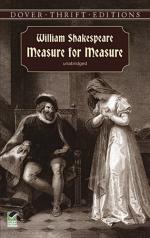|
This section contains 10,441 words (approx. 35 pages at 300 words per page) |

|
SOURCE: Lanier, Gregory W. “Physic That's Bitter to Sweet End: The Tragicomic Structure of Measure for Measure.” Essays in Literature 14, no. 1 (Spring 1987): 15-36.
In the following essay, Lanier presents a structural analysis of Measure for Measure, seeing in its divided form “a juxtaposition of two dramatic modes, tragedy and comedy, carefully poised to create a cohesive, resonant unity.”
In 1949 E. M. W. Tillyard bisected Measure for Measure into potentially tragic verse and dissolutely comic prose; some years earlier G. Wilson Knight asserted that the symbolic sequence of transgression, judgment, and redeeming mercy provides an innate structural integrity.1 This polarity in critical responses has proved to be nearly as enduring as the play itself. Cynthia Lewis provides a short summary of this division in her recent article:
Readers who, like Harriett Hawkins, find the play's ending “not only aesthetically and intellectually unsatisfying, but personally infuriating,” usually see Measure for...
|
This section contains 10,441 words (approx. 35 pages at 300 words per page) |

|


